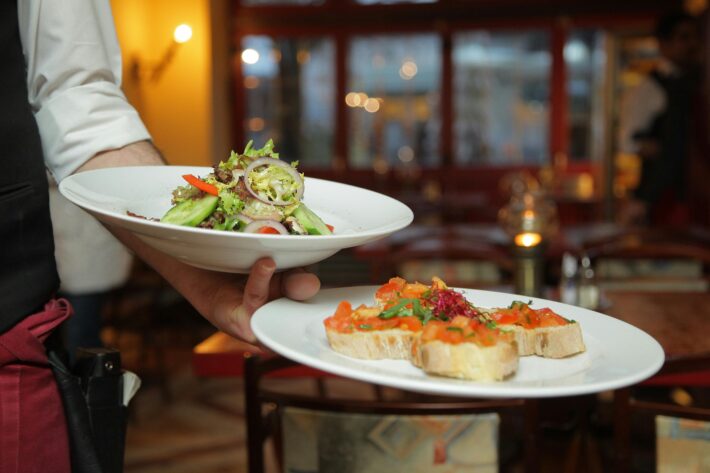The Impact of AI on Restaurant Loyalty Programs

Introduction
In recent years, the restaurant industry has undergone a seismic shift due to technological advancements, particularly in artificial intelligence. The integration of AI in food & restaurants is revolutionizing how businesses engage with their customers, manage operations, and ultimately enhance loyalty programs. As competition intensifies, restaurants are increasingly looking for innovative solutions to attract and retain customers.
Consider the case of Domino’s Pizza, which has successfully utilized AI to personalize customer experiences. The company’s AI-driven loyalty program analyzes customer data to offer tailored discounts and promotions, resulting in a significant increase in customer retention rates. This example sets a compelling stage for understanding how AI can transform loyalty programs in the restaurant sector. The relevance of this topic cannot be overstated, as restaurants that adapt to these changes are likely to thrive while those that resist may struggle to survive.
In this blog post, we will delve deep into the impact of AI on restaurant loyalty programs, exploring key strategies, best practices, and real-world case studies that showcase both the successes and pitfalls of implementing AI-driven solutions.
Key Strategies for AI in Food & Restaurants
1. Personalized Customer Engagement
One of the most impactful strategies for leveraging AI in food & restaurants is personalized customer engagement. This approach focuses on using data analytics to tailor marketing efforts and improve customer experiences based on individual preferences.
#### What it is
Personalized customer engagement involves collecting and analyzing customer data to understand their behavior, preferences, and purchasing patterns. AI algorithms can process vast amounts of data quickly, allowing restaurants to craft tailored marketing messages, rewards, and loyalty offers.
#### Why it matters
Research has shown that personalized marketing can significantly increase customer engagement and retention. According to a study by McKinsey, businesses that excel at personalization can generate 40% more revenue from those activities than average players.
#### How to implement it
1. Data Collection: Start by collecting customer data through various touchpoints such as mobile apps, online orders, and loyalty program sign-ups.
2. Data Analysis: Use AI tools to analyze the data and identify trends and preferences.
3. Targeted Promotions: Create tailored promotions based on individual customer profiles. For instance, if a customer frequently orders vegetarian dishes, send them exclusive offers on new vegetarian menu items.
4. Feedback Loop: Continuously gather feedback to refine your personalization strategies.
5. AI Chatbots: Implement chatbots to engage customers in real-time and offer personalized recommendations.
#### Real-world example
Starbucks has successfully implemented personalized customer engagement through its loyalty program, which utilizes AI to analyze customer preferences. The Starbucks app provides personalized offers and rewards based on individual purchasing habits, resulting in a 26% increase in customer retention.
#### Key Benefits
- Increased Engagement: Personalized offers lead to higher customer engagement.
- Boosted Sales: Tailored promotions can drive additional sales.
- Enhanced Loyalty: Customers feel valued when they receive customized experiences.
For more insights on how personalization improves customer engagement, check out this article from Harvard Business Review.
2. AI-Driven Predictive Analytics
Another powerful strategy is the use of AI-driven predictive analytics to enhance loyalty programs. This technique helps restaurants forecast customer behavior and optimize their offerings accordingly.
#### What it is
Predictive analytics involves using statistical algorithms and machine learning techniques to identify the likelihood of future outcomes based on historical data. In the context of AI in food & restaurants, this could mean predicting customer preferences, peak dining times, or menu item popularity.
#### Why it matters
By understanding future trends, restaurants can make informed decisions about inventory, staffing, and marketing strategies. A study by Deloitte found that organizations utilizing predictive analytics are 2.9 times more likely to report revenue growth.
#### How to implement it
1. Data Gathering: Collect historical data on sales, customer visits, and menu item performance.
2. AI Integration: Use AI tools to analyze this data and identify patterns.
3. Forecasting: Create forecasts for customer behavior and preferences.
4. Menu Optimization: Adjust menu offerings based on predicted customer demand.
5. Dynamic Pricing: Implement dynamic pricing strategies to maximize revenue during peak times.
#### Actionable takeaways
- Utilize AI tools to analyze customer behavior trends.
- Optimize inventory and staffing based on predictive insights.
- Regularly update marketing strategies to align with predicted customer preferences.
According to a recent study published by Forbes, companies employing predictive analytics have seen a 10%-20% increase in sales.
Best Practices for AI in Food & Restaurants
Key Actionable Tips
#### 1. Embrace Omnichannel Loyalty Programs
Creating an omnichannel loyalty program allows customers to earn rewards across various platforms, whether online, in-app, or in-store. This seamless experience encourages more frequent visits and higher spending.
Example: A restaurant chain could offer a loyalty app where customers can place orders, earn points, and redeem rewards both online and in-store.
#### 2. Leverage AI for Customer Insights
Utilizing AI to gather customer insights can help restaurants tailor their offerings. By analyzing customer feedback, reviews, and social media interactions, businesses can identify areas for improvement.
Statistic: According to a survey by Statista, 91% of customers read online reviews before visiting a restaurant, emphasizing the need for businesses to understand their public perception.
#### 3. Foster Community Engagement
Restaurants can utilize AI-driven social media tools to engage with their communities. By analyzing customer interactions, businesses can develop targeted content that resonates with their audience, driving loyalty.
Example: A local eatery could launch a campaign on social media, encouraging customers to share their dining experiences in exchange for loyalty points.
Common Mistakes to Avoid
#### Mistake 1: Neglecting Data Security
With the increase in data collection comes the responsibility of protecting customer information. Failing to implement robust security measures can lead to data breaches and loss of customer trust.
How to avoid: Invest in cybersecurity measures and ensure compliance with regulations like GDPR.
#### Mistake 2: Overcomplicating the Loyalty Program
Many restaurants make the mistake of creating overly complex loyalty programs that confuse customers.
Real-world example: A restaurant chain launched a loyalty app that required customers to navigate multiple screens to redeem rewards, resulting in low adoption rates.
To avoid this, keep loyalty programs simple and intuitive.
Real-World Case Studies
Case Study 1: Chipotle’s AI-Driven Loyalty Program
Chipotle successfully implemented an AI-driven loyalty program that leverages customer data to offer personalized rewards. By analyzing purchase history and customer preferences, the brand has increased customer retention rates by 25% since launching the program.
Case Study 2: The Downfall of a Major Chain
A well-known restaurant chain attempted to implement AI in food & restaurants by introducing a complex loyalty app that failed to resonate with customers. The app’s confusing interface and lack of meaningful rewards led to its eventual discontinuation. Lessons learned include the importance of simplicity and customer feedback in designing loyalty solutions.
Conclusion
The integration of AI in food & restaurants is reshaping the landscape of loyalty programs, offering businesses unprecedented opportunities to engage customers on a deeper level. By implementing strategies focused on personalized engagement and predictive analytics, restaurants can significantly enhance their loyalty offerings.
As the industry continues to evolve, it is crucial for restaurant owners to stay ahead of the curve and embrace these technological advancements. For those looking to enhance their loyalty programs, the key lies in understanding customer preferences, leveraging data effectively, and fostering a community that keeps diners returning for more.
For more insights, check out our blog or contact us for expert guidance.


